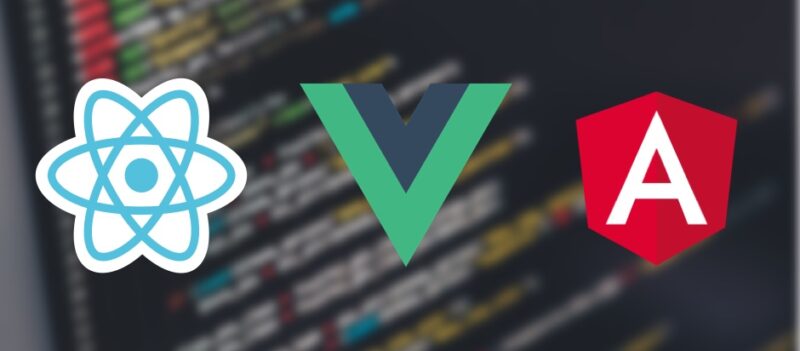JavaScript frameworks choice
Today, IT is the field moving towards mobile development, which is undoubtedly one of the fastest growing, profitable and popular direction in terms of the number of developers. The popularity and wide distribution of various mobile devices made a serious stir in the digital world, forcing many corporations to make a lot of effort to find a niche in the market of software products for mobile devices and not only.
On the other hand, web apps get more and more complicated with each year arising demand for highly-skilled web developers for complex enterprise or consumer-facing applications.
How and on what tools is it worth to write the code? This question often arises within people who have recently encountered software development. The sure way to find the answer is to test each modern framework and library by yourself, but this is an ideal option. Then follow a long process of “learning curve”, starting with simple designs, then gradually deepening into the chosen framework. But it takes a long time, which in some cases can lead to the loss of customers or funds, which is unacceptable in the current realities of the market. Therefore, many companies are often resorting to outsourcing or the complete transfer of development from in-house to major research and development centers in other countries.
Frameworks comparison
In this part, let’s talk about how to compare Vue vs Angular vs React, because not all of these tools are similar, although they have much in common.
React JS vs Vue JS
React vs Vue is one of the interesting questions because both of these tools can be considered similar.
For example, the representation of components is similar – both linked and the reactive components are supported. Nevertheless, the “internal implementation” of frameworks differs to a much greater extent. React is based on a virtual DOM, and it shows how this DOM looks ” in real” in memory. As for the data – for the most part, it stays unchanged, and the changes in the DOM are recounted on the basis of the differences.
In Vue.Js the situation is opposite – the data is variable, and instead of approaching a virtual DOM, this tool works with DOM as a template. However, all references to the existing nodes are preserved.
React JS vs Angular JS
If we consider this issue from React side, then this framework was created for one important goal: the construction of high-speed and responsive interfaces. Thus, to enable quick drawing of a large amount of data. As mentioned above, React also uses DOM, which means it quickly draws the changed parts of the page but not the whole page.
On the other hand, Angular is a more formal framework and sets its tone in creating applications, i.e. It is aimed at a certain architecture. In case, if you need to do something different – you can face with difficulties. Working with React has no such drawback and does not bind the developer to a specific application structure and reduces the load time.
Regarding speed and performance: although the presentation of data within Angular implies a compact view, still processing a large amount of data can cause difficulties. This happens due to the fact that, for example, a two-way data connection requires a handler for each of the mutable elements. Therefore, it is logical that a large amount of processed data with this approach consumes a lot of time and resources. When using React, the situation changes in the better way, since this framework uses DOM, which allows to track certain changes and not render the entire page anew. The principle of work is when changes are detected, the framework creates a list of it and draws only those parts of the page where the changes were found.

Vue JS vs Angular JS
There are many reasons why devs should use Vue.js instead of the usual AngularJs. Of course, this approach can be called subjective (not), and not all of the listed advantages can find a place in most projects, but:
Vue is easier – in development, design, and API, so learning curve becomes quite low and the speed of applications creation also decreases (although everything depends on the particular project).
Vue.Js is less straightforward in solving most problems, and therefore allows you to be slightly more flexible in writing code. This approach gives more space for a stretch of the imagination and does not force a developer to do everything “patterned” like in Angular. The Advantage and, for some – disadvantage, that Vue is a layer of representation, so it can be easily used instead of large frameworks, which makes it possible to compile and combine Vue with all sorts of other libraries. Although in this case the application architecture, of course, can become unpredictable (not). Also worth noting to say that it has Ajax functions support “from the box”, which is a big plus compared to the opponent.
Also, developers note the fast (in comparison with Angular) speed of work, in large part because of the presence in the list of watchers: in the case of data change in their visibility, it needs to perform a new render. In Vue this problem is solved due to a more “transparent” system of watchers – if there are dependencies and connections, the necessary changes are called automatically.
Angular vs React vs Vue
As a result, we want to say that all of the above libraries and frameworks offer an excellent and great set of possibilities. Most likely the choice to a greater extent can arise with a problem but it can be easily solved with the help of a specific instrument. For example, Vue can be considered as one that more simple to use, React is a bit more “wide-range-use”, and Angular can conduct parallel development within a single project. It should be noted that Vue supports JSX, but this approach in creating Vue-applications is rarely used.
